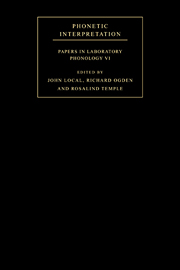Book contents
- Frontmatter
- Contents
- List of contributors
- Acknowledgements
- Introduction
- Part I Phonological representations and the lexicon
- Part II Phonetic interpretation and phrasal structure
- Part III Phonetic interpretation and syllable structure
- Part IV Phonology and natural speech production: tasks, contrasts and explanations
- 16 The interaction of the phonetics and phonology of gutturals
- 17 Pitch discrimination during breathy versus modal phonation
- 18 The phonetic interpretation of register: evidence from Yorùbá
- 19 Speech rhythm in English and Japanese
- 20 Commentary: on the interpretation of speakers' performance
- References
- Index of names
- Index of subjects
17 - Pitch discrimination during breathy versus modal phonation
Published online by Cambridge University Press: 22 September 2009
- Frontmatter
- Contents
- List of contributors
- Acknowledgements
- Introduction
- Part I Phonological representations and the lexicon
- Part II Phonetic interpretation and phrasal structure
- Part III Phonetic interpretation and syllable structure
- Part IV Phonology and natural speech production: tasks, contrasts and explanations
- 16 The interaction of the phonetics and phonology of gutturals
- 17 Pitch discrimination during breathy versus modal phonation
- 18 The phonetic interpretation of register: evidence from Yorùbá
- 19 Speech rhythm in English and Japanese
- 20 Commentary: on the interpretation of speakers' performance
- References
- Index of names
- Index of subjects
Summary
Introduction
The typology of linguistic sound patterning indicates an extreme dispreference for the simultaneous implementation of contrastive tone and contrastive non-modal phonation. Accordingly, I performed a psychoacoustic experiment to investigate whether human auditory perceptual limitations may play a role in this aspect of phonological systems. The experiment consisted of subjects listening to pairs of stimuli – modally phonated pairs and breathy pairs, deriving from the natural speech of Jalapa Mazatec speakers – which differed in pitch to varying degrees. Subjects were asked to judge whether the two stimuli were the same or different in pitch. I found that, indeed, listeners are better at discerning pitch differences in complex tones implemented during modal phonation than they are discerning pitch differences implemented during breathy phonation.
Background
Moore (1989) discusses a number of relevant findings in the domain of human perception of complex tones. I summarise here the most pertinent among them.
The lowest harmonics up to the fifth seem to dominate for the purpose of pitch perception. In this harmonic range, resolution of individual overtones is possible. A pattern-recognition model of pitch perception (deriving from Terhardt's models, e.g. 1974, and studies by Ritsma 1962, 1963, 1967 and Plomp 1967) has been offered to account for this finding, in which the values of individual harmonics are determined, and the distance between these harmonics is subsequently calculated, culminating in a pitch percept. However just-noticeable differences (JNDs) found in human pitch perception cannot be explained by this theory alone.
- Type
- Chapter
- Information
- Phonetic InterpretationPapers in Laboratory Phonology VI, pp. 293 - 304Publisher: Cambridge University PressPrint publication year: 2004



